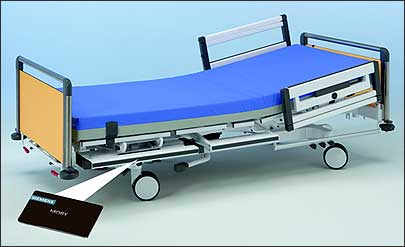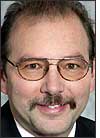The Bielefeld City Clinics, a public hospital in northern Germany, is moving into the second phase of a test designed to use radio frequency identification to expedite the cleaning of beds.
Working with Siemens IT Solutions and Services and bed maker Joh. Stiegelmeyer GmbH & Co., the hospital carried out the first phase of the test from June 2006 until early this year. Now, the partners plan to expand the application to additional wards so they can collect enough data to calculate how much money the hospital would save by using RFID to track all of its beds. Before the tests were conducted, no tracking system was in place.

Thomas Jell, who heads RFID projects for Siemens IT Solutions and Services, says his company implemented a similar project at Inselspital (the University of Bern Hospital) in Switzerland: From November 2005 to September 2006, Inselspital—Switzerland’s oldest and largest university hospital—tagged 1,600 beds and mattresses. The facility believes it could save approximately 200,000 Swiss francs ($171,000) each year by using the RFID application. Based on the proof-of-concept, Jell says he believes the Bielefeld hospital could achieve an even higher return on its investment than the one in Bern, though he declines to reveal further details. Inselspital, meanwhile, is considering a full-scale application that would tag every bed and mattress in the hospital.
During phase two of the Bielefeld project, beds and mattresses in at least two new wards will be outfitted with RFID tags. A business-card-sized RFID tag will be slipped into a plastic pocket on each mattress, while each bed will carry a tag inside a protective plastic casing mounted near the foot of the bed, on a platform support. The casing will keep the tag from being damaged if a bed runs into a wall or bumps an elevator door, while also keeping water and soap away from the transponder during the cleaning process. A plastic label will cover the mattress chip. Stiegelmeyer (which manufactures the beds) will apply tags to the beds and mattresses before delivering them to Bielefeld.
Siemens is supplying passive UHF 869 MHz RFID tags for the application. The tags comply with the EPCglobal Gen 2 standard, and are encoded only with a unique identification number. Mattress tags cost about €0.50 ($0.72) apiece, Jell says, while beds tags cost between €1 and €2 ($1.44 and $2.87) due to the expense of the plastic cover. Siemens is also providing the interrogator antennas used in the application.
Once a patient no longer needs a bed, a head nurse uses the hospital’s bed-management software, known as b.loc, to indicate whether that bed and its mattress should be completely disinfected or just cleaned (based, for example, on whether the patient using the bed had a highly infectious disease, or just a twisted knee). Another nurse or assistant brings the bed into the hallway, where it is eventually wheeled to an elevator and taken to the basement.
Upon arrival at the basement, the beds are taken to a central holding room. From there, workers push the beds past a wall-mounted RFID interrogator antenna, which reads the mattress and bed tags. The computer system informs the employees where to send each bed—either through an automatic bed-washing machine with the highest heat and longest duration settings, or through another one that merely washes down the beds. The bed is taken to the appropriate station, where its wheels are placed on a track, much like that used in an automatic car wash.
The track transports the bed and mattress through the station, until it emerges dry on the other end. At that point, the second and final tag interrogation is conducted, and the system is updated so hospital administrators can determine the number of available clean beds at any given time.
Each bed and mattress is tagged individually, because the hospital requires separate information regarding availability. A bed might need to be repaired but its mattress might be immediately reusable, or vice versa. After the cleaning, a worker checks the bed and mattress to make sure neither has been damaged, then wraps a green sheath over them to keep out dust until the bed can be reused. During the testing period, the hospital employed roughly 500 tags, 250 on beds and the other half on mattresses.
Bielefeld City Clinics conducts about 40,000 to 50,000 cleanings per year. The hospital is interested in RFID because it hopes the application can save it money and reduce any potential environmental impact by cutting down on unnecessary cleanings. By discerning which beds need a full-works wash and which can be cleaned less vigorously, the hospital hopes to save on cleaning supplies, reduce working time for personnel and limit the need for bed-frame repairs (since the number of repairs rises consistently as the number of washings increases).
While preparing for the second phase of the project, the partners plan to interrogate tags as the beds and mattresses enter the bed-washing machine as well. Once this additional point is added to the process, a green or red light will indicate if workers are wheeling a bed toward the proper machine.


